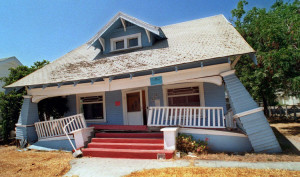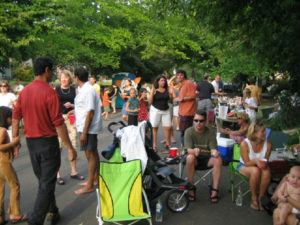How many of you live within walking distance of your friends and family? Probably not many. When the Cascadia quake hits, there will be no more internet, cell phones, or visits to friends across town. Your radius will shrink. The people in your world will be those who are actually right there near you. And there’s a good chance it will happen when you’re at home.
WHO WILL COME TO YOUR AID?
Government assistance may take weeks to arrive. Our immediate survival and long-term comfort in a disaster can depend on our connections. If your loved ones are unable to help and you don’t know your neighbors,
Who will come get you out of your collapsed house?
Who will know to look for your children or pets?
Who will put out the fire if you are not there?
Who will you band together with to share skills and supplies?
DISASTERS CREATE COMMUNITY
From that first rescue to the procuring of water, food, and medicine, we will all likely need some help. When we trade help with those near to us, we will create new close bonds based on real human needs and personal contact. We will come to know who we can trust. People will be forced to cooperate when services and supply streams fail.
BEFORE A DISASTER FORCES IT
While disasters will create communities out of necessity, having strong communities in place before a disaster is far more effective. So how can we build a sustainable community that looks out for its members? How can we function like a tribe, with personal accountability and respect? The tribes that we create around sports teams or musical preferences may be useless in the face of real adversity, but good relations with our close neighbors could save our lives.
Many of us are not comfortable knocking on doors and introducing ourselves to neighbors. We’ve become accustomed to building social bubbles and respecting others’ bubbles to the point of not knowing the person living next door. Inviting neighbors to a Map Your Neighborhood party is a good way to break the ice. You can convene around the topic of neighborhood earthquake planning and get to know each other personally in the process.
- Make it a potluck – everyone loves food!
- Do it in August – the City of Portland waives block-party fees in celebration of National Night Out (check out their great Game Ideas).
- Don’t forget to emphasize the fact that if nothing else, everyone should be stockpiling water.
THE INTERNET CAN HELP
Social media can aid us in getting to know our neighbors. There are a number of platforms that seek to bring people together locally to convene around various topics or exchanges. Among others, NextDoor and Buy Nothing are active in Portland and worth considering.
- NextDoor.com seeks to build stronger and safer neighborhoods by providing a space for people to do things like: spread the word about a stolen car, organize a Neighborhood Watch Group, find a trustworthy babysitter, ask neighbors to keep an eye out for a lost dog, find a new home for an outgrown bike, or advertise a Neighborhood Emergency Team meeting. These online interactions often lead to in-person community building.
- The Buy Nothing Project on Facebook allows people to share good, skills, and knowledge in a format that values human connection above all else. The project’s values state, “We believe our hyper-local groups strengthen the social fabric of their communities, and ensure the health and vitality of each member… We measure wealth by the personal connections made and trust between people.”
GO SHAKE SOME HANDS
 Nothing can beat chatting with your neighbors on a regular basis. Make a point of waving and saying hello more. Make an opportunity to talk to the senior across the street about her garden. Make a double batch of muffins and go chat with the family next door.
Nothing can beat chatting with your neighbors on a regular basis. Make a point of waving and saying hello more. Make an opportunity to talk to the senior across the street about her garden. Make a double batch of muffins and go chat with the family next door.
It behooves us to prioritize people in a face-to-face way. Our most important preparedness (and happiness) goal may be to build close-proximity relationships. Long distance doesn’t help when you’re trapped under debris.
–Written by Laura Hall and Teresa Gryder


